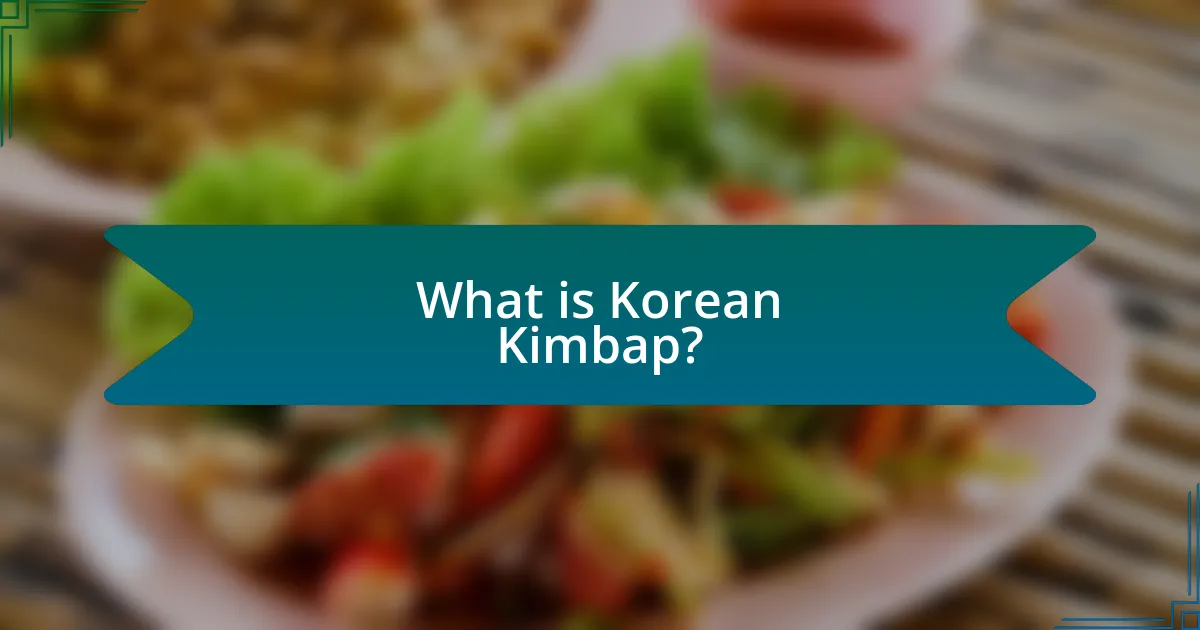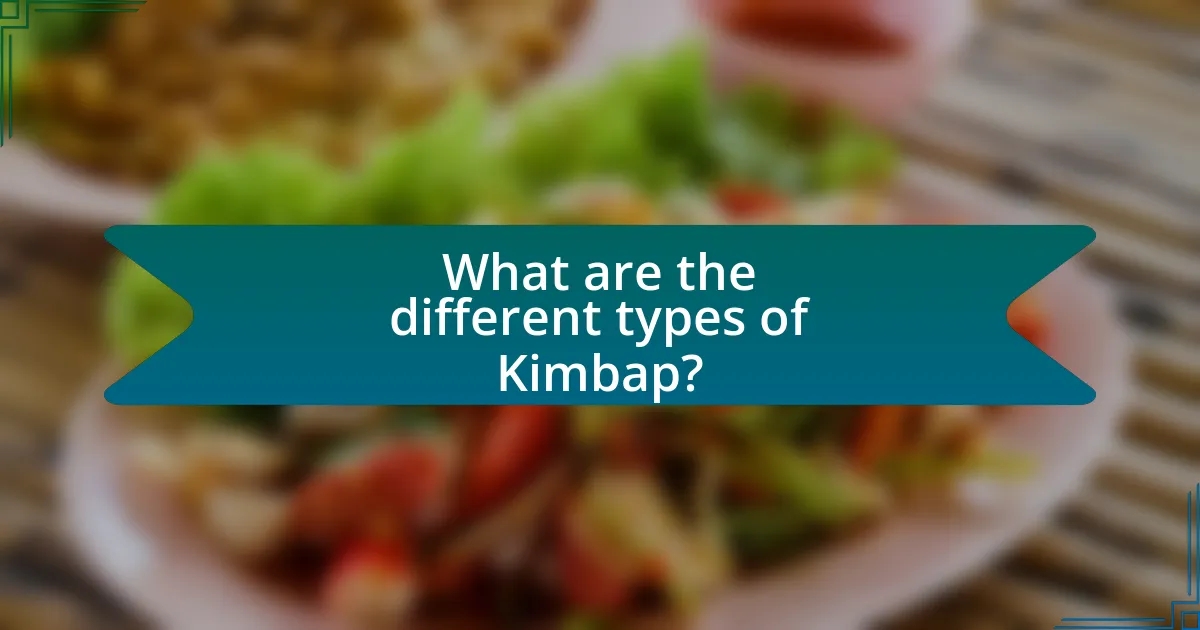Korean Kimbap is a traditional dish made of seasoned rice and various fillings rolled in seaweed, often enjoyed as a snack or picnic food. This article explores the differences between Kimbap and sushi, key ingredients, and the cultural significance of Kimbap in Korean society, particularly during family gatherings and celebrations. It also highlights various types of Kimbap, regional specialties, and provides guidance on how to prepare Kimbap at home, including essential tools and techniques. Additionally, the article offers tips for customization, common mistakes to avoid, and serving suggestions to enhance the Kimbap experience.

What is Korean Kimbap?
Korean Kimbap is a traditional Korean dish consisting of rice and various ingredients rolled in seaweed. The rice is typically seasoned with sesame oil and salt, while the fillings can include vegetables, fish, or meat, making it a versatile meal option. Kimbap is often served as a picnic food or snack and is distinct from sushi, as it does not usually contain raw fish. The dish has cultural significance in Korea, often associated with family gatherings and outdoor activities.
How is Kimbap different from sushi?
Kimbap is different from sushi primarily in its ingredients and preparation methods. Kimbap typically uses sesame oil, vegetables, and cooked proteins like beef or egg, while sushi often features raw fish and vinegared rice. Additionally, kimbap is usually served as a snack or picnic food in Korea, whereas sushi is often consumed as a delicacy in Japanese cuisine. The rice in kimbap is not seasoned with vinegar, which is a key characteristic of sushi rice, further distinguishing the two dishes.
What are the key ingredients in Kimbap?
The key ingredients in Kimbap are rice, seaweed, and various fillings. The rice is typically seasoned with sesame oil and salt, while the seaweed, known as gim, serves as the outer layer. Common fillings include vegetables such as cucumber, pickled radish, and carrots, along with proteins like beef, fish, or eggs. These ingredients combine to create a balanced and flavorful dish, reflecting traditional Korean culinary practices.
Why is the preparation method significant?
The preparation method is significant because it directly influences the texture, flavor, and nutritional value of Korean kimbap. The specific techniques used, such as the way rice is cooked and seasoned, affect the overall taste and consistency of the dish. For instance, using short-grain rice, which is sticky, allows the kimbap to hold its shape better when rolled, enhancing the eating experience. Additionally, the inclusion of fresh ingredients and the method of rolling contribute to the balance of flavors and textures, making kimbap not only a culinary delight but also a nutritious meal option.
What cultural significance does Kimbap hold in Korea?
Kimbap holds significant cultural importance in Korea as a traditional dish often associated with family gatherings, picnics, and celebrations. This rice roll, typically filled with various ingredients such as vegetables, meat, and pickled items, symbolizes togetherness and communal eating in Korean culture. Historically, kimbap was created as a portable meal for workers and travelers, reflecting the practicality and resourcefulness of Korean cuisine. Its presence in social events and festivals further emphasizes its role in fostering connections among people, making it a staple in both everyday life and special occasions.
How is Kimbap traditionally served during celebrations?
Kimbap is traditionally served during celebrations as a symbol of good fortune and prosperity. It is often presented in a colorful and visually appealing manner, with various ingredients like vegetables, fish, and meat rolled in rice and seaweed. The vibrant colors and diverse fillings are believed to bring joy and happiness to the occasion, making it a popular dish for birthdays, weddings, and other festive gatherings in Korean culture.
What role does Kimbap play in Korean family meals?
Kimbap serves as a staple dish in Korean family meals, often symbolizing togetherness and shared experiences. This rolled rice dish, filled with various ingredients such as vegetables, meat, and pickled items, is commonly prepared for family gatherings, picnics, and celebrations. Its versatility allows families to customize fillings based on preferences, making it a popular choice for communal dining. Kimbap’s presence in family meals reflects cultural values of unity and nourishment, as it is typically enjoyed in a shared setting, reinforcing familial bonds.

What are the different types of Kimbap?
There are several types of Kimbap, each distinguished by their fillings and preparation methods. Common varieties include Gimbap, which typically contains ingredients like pickled radish, spinach, and egg; Tuna Kimbap, featuring canned tuna mixed with mayonnaise; and Bulgogi Kimbap, which includes marinated beef. Other types are Kimchi Kimbap, incorporating kimchi for a spicy flavor, and Vegetable Kimbap, focusing on a variety of vegetables. Each type reflects regional preferences and personal tastes, showcasing the versatility of this traditional Korean dish.
How do the ingredients vary among Kimbap types?
The ingredients in Kimbap vary significantly among its types, reflecting regional preferences and specific recipes. For instance, traditional Kimbap typically includes ingredients like pickled radish, spinach, and egg, while variations such as Tuna Kimbap incorporate canned tuna and mayonnaise, and Kimchi Kimbap features fermented kimchi. Additionally, vegetarian versions may use ingredients like cucumber and carrots, while meat-based Kimbap can include bulgogi or other cooked meats. This diversity in ingredients allows for a wide range of flavors and textures, catering to different tastes and dietary preferences.
What are the most popular variations of Kimbap?
The most popular variations of Kimbap include Gimbap, Tuna Kimbap, and Jeon Kimbap. Gimbap is the classic version, typically filled with ingredients like pickled radish, spinach, and egg. Tuna Kimbap incorporates canned tuna mixed with mayonnaise, offering a seafood twist. Jeon Kimbap features savory pancakes as a filling, adding a unique texture and flavor. These variations reflect the versatility of Kimbap, which can be adapted to include a wide range of ingredients based on personal preferences and regional specialties.
How does vegetarian Kimbap differ from traditional Kimbap?
Vegetarian Kimbap differs from traditional Kimbap primarily in its filling ingredients, as vegetarian Kimbap excludes meat and fish, focusing instead on vegetables and plant-based components. Traditional Kimbap typically includes protein sources such as beef, fish, or egg, alongside vegetables and rice, while vegetarian Kimbap features ingredients like cucumber, pickled radish, carrots, and sometimes tofu or other plant-based proteins. This distinction caters to dietary preferences and restrictions, making vegetarian Kimbap a suitable option for those following a vegetarian lifestyle.
What are the regional specialties of Kimbap in Korea?
The regional specialties of Kimbap in Korea include variations such as Jeonju Kimbap, which is known for its rich filling of beef, pickled radish, and egg, and Busan Kimbap, characterized by its use of fresh seafood like tuna and crab. Additionally, Gwangju Kimbap often features a unique blend of local vegetables and spicy ingredients, reflecting the region’s culinary preferences. These specialties highlight the diverse ingredients and preparation methods influenced by local tastes and available resources across different regions of Korea.
How does the preparation differ in various Korean provinces?
The preparation of kimbap differs significantly across various Korean provinces, reflecting local ingredients and culinary traditions. For instance, in Jeolla Province, kimbap often includes a variety of seasonal vegetables and is known for its rich flavor due to the use of sesame oil and pickled ingredients. In contrast, Gyeongsang Province tends to emphasize simpler, more straightforward flavors, often using fewer ingredients and focusing on the quality of the rice and seaweed. Additionally, the use of protein varies; for example, Busan is famous for its seafood kimbap, incorporating fresh fish, while inland provinces may favor beef or pork. These regional variations highlight the diverse culinary landscape of Korea, where local tastes and available ingredients shape the preparation of kimbap.
What unique ingredients are used in regional Kimbap?
Regional Kimbap features unique ingredients that vary by locality, such as perilla leaves in Gyeonggi Province, which add a distinct flavor, and tuna or crab meat in Busan, reflecting the coastal area’s seafood availability. Additionally, Jeolla Province often incorporates seasonal vegetables like pickled radish and various types of mushrooms, enhancing the dish’s taste and texture. These regional variations highlight the adaptability of Kimbap to local ingredients and culinary traditions.

How can you make Kimbap at home?
To make Kimbap at home, prepare cooked rice, seaweed sheets, and various fillings such as vegetables, eggs, and protein. First, cook short-grain rice and season it with sesame oil and salt. Next, lay a seaweed sheet on a bamboo mat, spread a thin layer of rice evenly, and add your chosen fillings in a line. Roll the mat tightly to form a cylinder, then slice the roll into bite-sized pieces. Kimbap is a popular Korean dish, often enjoyed as a snack or meal, showcasing the versatility of ingredients and flavors.
What are the essential tools needed for making Kimbap?
The essential tools needed for making Kimbap include a bamboo mat, a sharp knife, and a rice cooker. The bamboo mat is crucial for rolling the Kimbap tightly and evenly, while the sharp knife is necessary for cutting the rolled Kimbap into bite-sized pieces without squishing it. A rice cooker is important for preparing the rice, ensuring it is cooked to the right texture for rolling. These tools are fundamental for achieving the traditional Kimbap preparation and presentation.
How do you prepare the rice for Kimbap?
To prepare the rice for Kimbap, first, rinse short-grain rice under cold water until the water runs clear to remove excess starch. Then, cook the rice in a rice cooker or on the stovetop with a 1:1 ratio of rice to water, allowing it to steam for about 10-15 minutes after boiling. Once cooked, mix the rice with a small amount of sesame oil and salt for flavor. This method ensures the rice is sticky enough to hold the Kimbap together while providing a subtle taste that complements the fillings.
What techniques are used for rolling Kimbap effectively?
To roll Kimbap effectively, the primary technique involves using a bamboo mat to create even pressure while rolling. This ensures that the ingredients are tightly packed and the roll maintains its shape. Additionally, spreading the rice evenly across the seaweed, leaving a small border at the top, is crucial for a secure seal. The use of a firm yet gentle rolling motion helps to avoid crushing the ingredients, while applying slight pressure as you roll ensures a compact structure. Finally, sealing the edge of the seaweed with a bit of water or rice helps to keep the roll intact. These techniques are essential for achieving a well-formed Kimbap that holds together during slicing and serving.
What tips can enhance your Kimbap-making experience?
To enhance your Kimbap-making experience, focus on using high-quality ingredients and proper techniques. Fresh vegetables, premium rice, and authentic seaweed significantly improve the flavor and texture of Kimbap. For instance, using short-grain rice, which is stickier than long-grain rice, helps the Kimbap hold together better. Additionally, ensure that the rice is seasoned with a mixture of vinegar, sugar, and salt to achieve the traditional taste. Properly preparing and cutting vegetables into uniform sizes allows for even distribution and a balanced bite. Lastly, rolling the Kimbap tightly and using a bamboo mat can help maintain its shape, making it easier to slice and serve.
How can you customize Kimbap to suit your taste?
You can customize Kimbap to suit your taste by varying the fillings and seasonings used. Common modifications include substituting traditional ingredients like pickled radish and spinach with alternatives such as avocado, cucumber, or grilled vegetables. Additionally, you can adjust the flavor profile by incorporating different proteins like tofu, crab meat, or beef, and enhancing the taste with sauces such as sesame oil or spicy gochujang. This flexibility allows for a personalized Kimbap experience that caters to individual preferences and dietary restrictions.
What common mistakes should you avoid when making Kimbap?
Common mistakes to avoid when making Kimbap include using the wrong type of rice, overfilling the rolls, and not properly seasoning the ingredients. Using short-grain rice is essential for achieving the right texture, as it helps the rice stick together. Overfilling can lead to difficulty in rolling and may cause the Kimbap to fall apart, while properly seasoning vegetables and proteins enhances the overall flavor. Additionally, not allowing the rice to cool before rolling can result in soggy Kimbap, as hot rice can make the seaweed too soft.
What are some serving suggestions for Kimbap?
Kimbap can be served with a variety of accompaniments to enhance its flavor and presentation. Common serving suggestions include pairing it with pickled radish, known as danmuji, which adds a tangy contrast to the savory rolls. Additionally, serving kimbap with a side of soy sauce or sesame oil for dipping can elevate the taste experience. For a more complete meal, kimbap is often accompanied by a bowl of soup, such as kimchi jjigae, which complements the dish’s flavors. These serving suggestions are widely practiced in Korean cuisine, making kimbap a versatile and enjoyable dish.
How can you pair Kimbap with side dishes?
Kimbap pairs well with various side dishes that enhance its flavors and textures. Common side dishes include pickled radish, known as danmuji, which provides a tangy contrast, and kimchi, offering a spicy kick. Additionally, seasoned vegetables like spinach or bean sprouts complement the rice and fillings in kimbap, adding nutritional value and crunch. These pairings are traditional in Korean cuisine, where balance in flavors is essential, making them ideal accompaniments to kimbap.
What beverages complement Kimbap well?
Green tea complements Kimbap well due to its light flavor and health benefits. The subtle taste of green tea enhances the fresh ingredients in Kimbap without overpowering them. Additionally, Korean barley tea, known as boricha, is another excellent pairing, as its nutty flavor balances the savory elements of Kimbap. Both beverages are commonly enjoyed in Korean cuisine, making them traditional choices that align with the meal’s cultural context.


